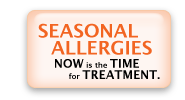Seasonal Allergic Rhinitis and Asthma
- Seasonal allergic rhinitis often referred to as "hay fever," affects more than 35 million people in the United States. These seasonal allergies are caused by substances called allergens. Airborne pollens and mold spores are outdoor allergens that commonly trigger symptoms during the spring and fall. During these times, seasonal allergic rhinitis sufferers experience increased symptoms-sneezing, congestion, a runny nose, and itchiness in the nose, roof of the mouth, throat, eyes and ears-depending on where they live in the country and the exact allergen to which they are allergic.
- Allergic Rhinitis is also caused by dustmites and animal dander and in such patients, symptoms are typically all year round hence the name perennial allergic rhinitis.
- At least 35.9 million people in the United States have seasonal allergic rhinitis (hay fever).
- There about 16.7 million office visits to health care providers annually for allergic rhinitis.
- The overall estimated cost of allergic rhinitis in the United States was $6 billion dollars in 1996 and has continued to rise.
- Allergen Immunotherapy is successful in up to 90% of patients with allergic rhinitis and 70 to 80% of patients with perennial allergic rhinitis.
- Allergic rhinitis can directly impact on asthma exacerbations for patients who have asthma. Uncontrolled rhinitis results in recurrent asthma exacerbations (extrinsic asthma), multiple physician office and emergency room visits, hospitalizations, days lost from school/work, astronomical increase in health care dollar, reduced productivity negatively impacts the economy and above all poor quality of life for the sufferers.
Frequently Asked Questions
Q: What is pollen?
A: Pollens are the tiny, egg-shaped male cells of flowering plants. Pollens from plants with bright flowers, such as roses, usually do not trigger allergies. These large, waxy pollens are carried from plant to plant by bees and other insects.
Q: What types of pollen trigger allergy symptoms?
A: Many trees, grasses and low-growing weeds have small, light, dry pollens that are well-suited for dissemination by wind currents. These are the pollens that trigger allergy symptoms. Seasonal allergic rhinitis in the early spring is often triggered by the pollens of such trees as oak, western red cedar, elm, birch, ash, hickory, poplar, sycamore, maple, cypress and walnut. In the late spring and early summer, pollinating grasses - including timothy, bermuda, orchard, sweet vernal, red top and some blue grasses - often trigger symptoms. Ragweed is the pollen most responsible for late summer and fall hay fever in North America.
Q: What is a pollen count?
A: Pollen counts measure the amount of airborne allergens present in the air. Counts are compiled by a variety of methods. Pollen counts are reported as grains per cubic meter of air. Certified aeroallergen counters at many universities, medical centers and clinics provide these counts on a volunteer basis.
Q: How do you acquire pollen counts?
A: The American Academy of Allergy, Asthma and Immunology has a network of pollen counters across the United States. Each counter works under the direction of an AAAAI member and must first pass an intensive certification course. Counters use air sampling equipment to capture air-borne pollens.
Q: Can weather affect a pollen count?
A: Weather can influence hay fever symptoms. Allergy symptoms are often minimal on days that are rainy, cloudy or windless, because pollen does not move about during these conditions. Hot, dry and windy weather signals greater pollen and mold distribution and therefore, increased allergy symptoms.
Q: Is the pollen season the same from year to year?
A: The beginning and ending times of tree, grass and weed pollen seasons are very similar from year to year in the same location. Intensity differs every year based on the previous year's weather, current weather, and other environmental factors
What to do if you are allergic to pollens
What to do if you are allergic to pollens
If you are allergic to plants, moving to another area of the country with different plants will not help to lessen your symptoms. Many pollens (especially grasses) and molds are common to most plant zones in the United States. Additionally, other related plants can also trigger the same symptoms. You may acquire allergies to new airborne allergens prevalent in the new area within one to two years. Therefore, moving to another part of the country to escape allergies is not recommended.
If your seasonal allergy symptoms are making you miserable, see your allergist/immunologist, who will take a thorough history and conduct tests, if needed, to determine exactly which pollens or molds are triggering your symptoms. He or she will help you determine when these airborne allergens are most prevalent in your area. To lessen your symptoms, your allergist/immunologist may also prescribe an allergy nose spray, non-sedating antihistamine, decongestant or other medications.
If your symptoms continue or if you have them for many months of the year, your allergist may also recommend immunotherapy treatment, also called allergy vaccinations or shots. This treatment involves receiving injections periodically as determined by your allergist/immunologist-over a period of three to five years. This treatment helps your immune system to become more and more resistant to the specific allergens and lessens your symptoms as well as the need for future medications.
Dos and don'ts
Following are some Dos and Don'ts that you may want to follow during the pollen and mold seasons to lessen your exposure to the pollens or molds that trigger your allergy symptoms.
DO keep windows closed at night to prevent pollens or molds from drifting into your home. Instead, if needed, use air conditioning, which cleans, cools, and dries the air.
DO minimize early morning activity when pollen is usually emitted-between 5-10 a.m.
DO keep your car windows closed when traveling.
DO try to stay indoors when the pollen count or humidity is reported to be high, and on windy days when dust and pollen are blown about.
DO take a vacation during the height of the pollen season to a more pollen-free area, such as the beach or sea.
DO take medications prescribed by your allergist/immunologist regularly, in the recommended dosage.
DON'T take more medication than recommended in an attempt to lessen your symptoms.
DON'T mow lawns or be around freshly cut grass; mowing stirs up pollens and molds.
DON'T rake leaves, as this also stirs up molds.
DON'T hang sheets or clothing out to dry. Pollens and molds may collect in them.
DON'T grow too many, or over water, indoor plants if you are allergic to mold. Wet soil encourages mold growth.
The content of this brochure is for informational purposes only. It is not intended to replace evaluation by a physician. If you have questions or medical concerns, please contact our office on 248-304-8904, Monday to Thursday; 08:30 AM – 5:00 PM and Friday; 08:30 AM – 12:00 Noon. contact our office
For more information on allergic rhinitis, call our office at 248-304-8904 for an appointment to speak with the Allergist/Immunologist.

